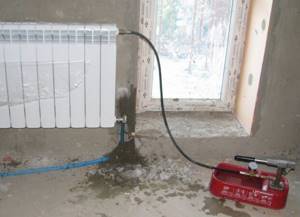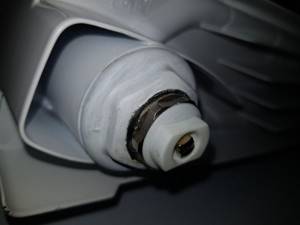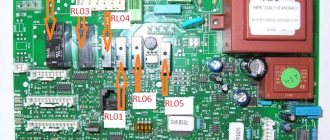Why are air locks dangerous?
The performance of a closed heating system depends entirely on the circulation of the coolant and the supply of a certain amount of heat to the radiators. If air appears in a closed heating system, the normal movement of fluid is disrupted. This phenomenon is considered unpleasant and can cause:
- characteristic noise during water movement. It should be noted that the pipes begin to vibrate, connections weaken, welds are destroyed;
- Air pockets form in the system. Air accumulated in remote areas of the system can disrupt water circulation, and if measures are not taken in a timely manner, the system can be defrosted;
- the efficiency of the heating system decreases, the consumption of fuel resources increases;
- Inside, air enters metal surfaces, contributing to the formation of corrosion.
Air accumulations in the heating system contribute to a shortening of its operational period and premature failure of the equipment.
Reasons for the appearance of air in the system
Where and why does air appear in the system if everything is sealed? There is no definite answer, but most often this happens in the following cases:
- the requirements for maintaining the slope of the pipes were violated;
- improper filling of the system with water, resulting in air remaining in the pipes;
- poor connection of components;
- lack of automation that independently removes air from the pipes, or its failure;
- performing repairs during which air definitely enters the pipes;
- filling the system with fresh water, which contains a lot of dissolved air. As soon as the temperature begins to rise, its content in the liquid decreases, and air pockets begin to form;
- the appearance of rust inside the system.
Improper filling of the system with water can cause air to appear
. These reasons cannot cover all possible cases, but with their help you can understand why the system is airy and take timely measures to remove the air lock.
Signs of air in the system
The accumulation of air in the heating system and the need to remove the airlock can be determined by the following signs:
- There is noise in the radiators. If the sounds resemble gurgling, then we confidently state the fact that air has appeared in the system;
- Batteries warm up unevenly. If you pay attention to the heat output of the radiator, it will immediately become clear what the main cause of the problem is. In addition to the dirt present inside the battery, an air lock may appear. The pipes remain hot, and the temperature in the radiator decreases slightly;
- A pressure drop can serve as a signal to bleed air in the heating system. In this case, it is necessary to carefully check the pipes for their integrity and the tightness of the joining areas and welds.
The signs given here are quite sufficient to understand that the system should be de-aerated.
Car and air-water conflict
Air in the car heating system is a common and unpleasant problem that has a number of causes. The cooling heating system protects the engine from overheating. Seemingly ordinary overheating can lead to the need to repair the engine.
So why does the car's heating system air? This is all due to the radiator, which is an important and mandatory part. One radiator is used for cooling, the second is for heating. The main problem of a radiator failure is a malfunctioning thermostat. The malfunction is manifested by the presence of hot air, in which the radiator itself remains cold. The solution to the problem is to replace the thermostat.
The second problem is poor cooling of the liquid. The antifreeze level should be below the filler neck. The most common problem is the lack of tightness of the lines that supply fluid to the pump.
Ways to solve the problem
In order to prevent the heating system from becoming airy, it should be properly designed and installed, periodically cleaned and filled with coolant without undue haste. Let's consider the main ways to help avoid such negative manifestations.
Correct installation
In heating systems in which the coolant circulates naturally, with the upper type of wiring, air is removed through the cover of the expansion tank. When installing such a system, the supply line is installed so that it approaches the tank vertically.
The tank, which provides free space for the expansion of the heated coolant, must be installed at the top point of the entire system to ensure the natural flow of liquid into the system circuit.
The return line is also installed with a slope along which the liquid moves freely.

Correct installation will help prevent air from entering the heating system.
If the installation of the heating system is carried out without errors, then the air appearing inside the circuit will be gradually squeezed out by the hot liquid to the top point, leaving the pipes through the open cover of the expansion tank.
Installation of air vents
How to promptly remove air accumulated in the heating system?
An open expansion tank must be installed in the upper part of the heating system, and a hermetically sealed one must be placed in the place where the return flow enters the boiler (before the pipe enters).
In such a system, supply pipes can be mounted without tilting, and the coolant will move under the influence of a circulation pump. In addition, other devices are installed through which air is discharged.
Air can be vented from the heating system itself through special air vents operating in automatic mode, installed on the rotating sections of pipes and at the highest point of the system. The plugs are removed from the radiators using a Mayevsky tap. Using the same principle, air is removed from the circuit through which water circulates naturally, but in this case, lower pipe routing must be done.
If everything is installed correctly, then there will be no problems with how to expel air from the heating system. It is enough to open the necessary taps, and as soon as the air leaves the system, close them again. Air vents operating in automatic mode do not need to be opened at all - their operating principle is based on changes in pressure.
If a closed heating system is installed, an automatic air vent must be installed in it. They are installed along the contour in certain places so that air pockets are removed locally. The idea is that each part of the heating system circuit must have the ability to vent air. An example of this is Mayevsky taps, which are installed on all radiators. Open them with a key or a screwdriver, allowing air to escape from the system. The procedure is quite simple, but with its help you can distribute the coolant evenly throughout the radiator.

An air vent can solve the problem with air in the heating system
To extend the operational life of the automatic air vent, it is necessary to install good filters and regularly flush the system.
Coolant heating
Sometimes, in order to remove excess air naturally, the coolant is simply heated strongly. An increase in temperature stimulates the release of air and its movement along the system circuit. It is allowed to heat the liquid in the pipes up to one hundred degrees.
If after such an operation air pockets appear again, it is necessary to check all connecting areas for leaks. Almost always, near the place where the air jam forms, there is a small gap from which water oozes out in small drops and into which air gradually penetrates. By sealing such a gap, you will immediately get rid of the annoying problem.
Radiators made of aluminum material are considered the most vulnerable places through which air passes. When an alloy is exposed to hot water, corrosion processes develop, accompanied by gas emissions.
If such radiators often become airy, it is recommended to simply replace them.
Operating principle of automatic air intake
This convenient and very functional device allows owners to forget about the need to remove air from the system themselves.

Automatic air collectors for heating systems function as follows:
- Water gets inside the mechanism with a plastic float.
- A float equipped with a flag exerts pressure on a spring-loaded rod.
- The air gets free outlet outside.
- The device is refilled with water and the cycle repeats.
Using one of the devices described above, photos of which can always be found from specialists who install such equipment, will allow you to forget about such a problem as airing the system and save residents time and money.
About airing the heating system in the video:
Preventive measures
We figured out why air appears in the heating system and how to deal with this negative fact. It remains to be seen whether there are preventive measures that help avoid such problems. It turns out yes:
- when installing a heating system, it is necessary to provide for the installation of special devices that automatically remove air;
- Before adding water to the heating system, you should bleed the air;
- During operation, you should monitor the operation of the entire system by observing the readings of pressure gauges and from time to time monitoring the pressure in the pipes. In addition, it is recommended to monitor the level of coolant in the expansion tank, conduct a visual inspection of pipes and radiators, and check the uniformity of heat distribution along the circuit;
- The system should be periodically pumped to remove all blockages.
The implementation of this set of measures will extend the operational period of the entire heating network.
Bleeding air from the heating network
Now let's figure out how to remove air from the heating system. To allow air to be vented from the heating network, special devices and taps are installed at the installation stage.
Air separator

The separator is not designed to bleed air, but to separate dissolved oxygen from the coolant. When water is heated, oxygen forms small bubbles. The separator can be installed anywhere in the network. As the coolant passes through this device, dissolved oxygen is converted into small bubbles, which are collected and removed from the circuit.
The air separator is an integral element of the separator unit. It is installed in the basement of a multi-story building. Improved separators remove air from the coolant and clean it of various impurities and polluting particles. These devices are often installed in houses with centralized heating networks.
Mayevsky crane
The fittings are installed on heating devices specifically to ventilate the circuit. Simply open the tap and bleed the air.
Mayevsky taps have a fitting. When it is opened, access to the heating networks is provided. Since plugs are collected at the top of the network or radiator, this valve is installed only on the top pipe. In high-rise buildings, Mayevsky cranes are mounted on devices installed in apartments on the top floor.
More often, this type of fittings is used in open-type systems with natural circulation, but circuits with forced coolant flow are not immune to the formation of air locks. The taps protect against a decrease in the heating efficiency of an apartment building.

There is no need to involve specialists to use the device. To bleed air, place a bucket or basin under the tap on the floor. Instead, you can attach a suitable length of hose to the faucet and lower one end into the sink or bathtub. This is done because a certain amount of coolant comes out along with the air pockets.
Replacing heating pipes in an apartment and how to hide them











